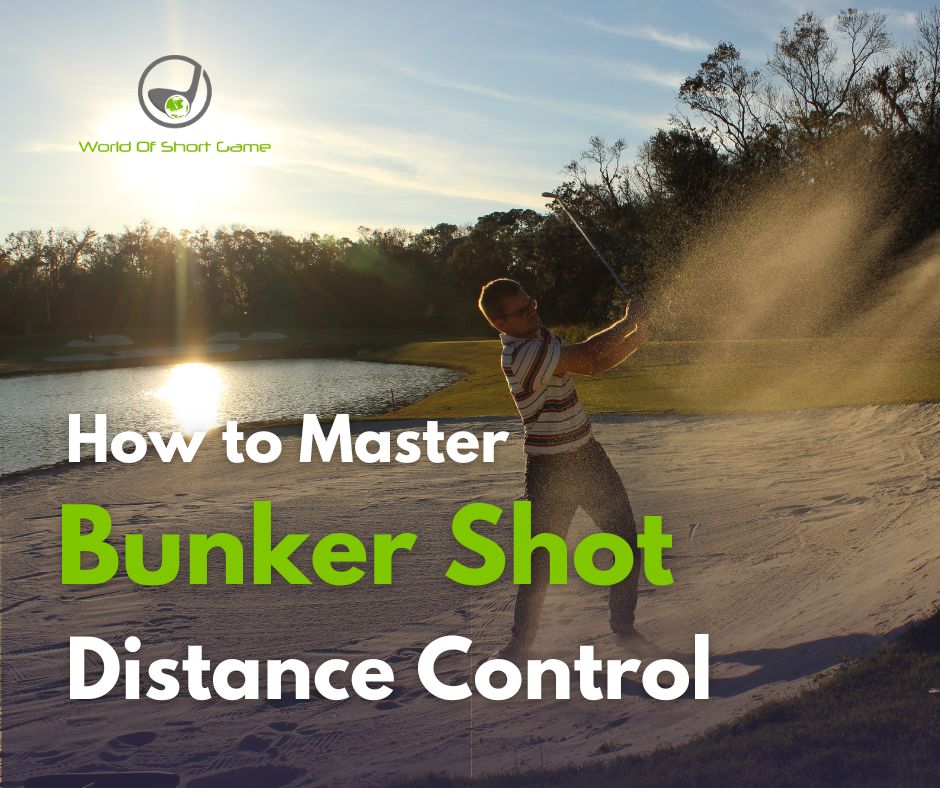- +4527976587
- mail@worldofshortgame.com

Bunker

How to Master Bunker Shot Distance Control
How to Master Bunker Shot Distance Control
Bunker Shot Distance Control – Bunker shots can be intimidating, especially when it comes to controlling distance. If you’re aiming to not only get out of the sand but also control your distance and land the ball close to the hole, you need to refine your technique and understand the variables that influence the distance of your bunker shots. In this article, we’ll walk you through how to master bunker shot distance control, focusing on swing speed, loft control, and where you hit the sand.
If you struggle with general consistency in your bunker shots, then you should start by checking out 15 Most Important Bunker Shot Basics You Must Know.
Swing Speed: How Much Force to Apply
The first factor in controlling your bunker shot’s distance is your swing speed. How fast you swing the club is a direct determinant of how far the ball will travel. Essentially, the combination of the length of your backswing and how much acceleration you generate in the downswing dictates your clubhead speed at impact.
- Shorter Bunker Shots: For shorter bunker shots, use a shorter backswing and less acceleration through impact. This results in lower clubhead speed, helping the ball travel a shorter distance.
- Longer Bunker Shots: For longer bunker shots, lengthen your backswing and maintain acceleration through the downswing. This creates more speed, sending the ball farther.
Pro Tip: Ensure a smooth, continuous motion without decelerating through the ball. Deceleration can cause the clubhead to get stuck in the sand, leaving your shot short.
Loft Control: Adjusting the Clubface
The second factor in bunker shot distance control is how much loft you have on the clubface. Adjusting the loft changes how high or low the ball will fly and how much it will roll.
- Open Clubface for Higher Shots: If you open the clubface, you increase the loft, causing the ball to fly higher and land softly, resulting in less roll. This is ideal for short bunker shots or when you need to carry the ball over a bunker lip.
- Closed Clubface for Lower Shots: If you close the clubface, you reduce the loft, allowing the ball to fly lower and roll out more. This is better for longer bunker shots where you need more distance after the ball lands.
Additionally, using different clubs for different distances can help control loft. A lob wedge (60 degrees) provides higher loft for shorter shots, while a pitching wedge (45 degrees) provides less loft and more roll for longer shots.
Pro Tip: When opening the clubface, make sure to adjust your aim left to compensate for the rightward direction the ball will take due to the open face.
Hitting the Sand: The Key to Consistency for Bunker Shot Distance Control
Perhaps the most critical factor in controlling bunker shot distance is where you hit the sand relative to the ball. When you strike the sand too far behind the ball, it slows down the clubhead significantly, causing the shot to travel a shorter distance. On the other hand, hitting the sand closer to the ball allows for a cleaner strike, resulting in more distance.
- More Sand = Shorter Shots: If you hit the sand 3-4 inches behind the ball, the clubhead will slow down significantly as it moves through the sand, causing the ball to travel a shorter distance. This technique is useful for close-range bunker shots.
- Less Sand = Longer Shots: To hit the ball farther, aim to strike the sand just 1-2 inches behind the ball. This allows the clubhead to maintain more speed, pushing the ball farther out of the bunker.
Pro Tip: Practice striking the sand consistently in the same spot, aiming to hit behind the ball to allow for a cushion of sand. This consistency will help you control distance more reliably. You can also try this drill that really improves the consistency of where you are hitting the sand: Better contact in the bunker with this simple drill
Loft and Bounce: Keeping Your Club Gliding Through the Sand
Loft control isn’t just about adjusting the clubface; you also need to manage the bounce of the club. Bounce refers to the angle between the leading edge of the club and the ground. More bounce allows the club to glide through the sand, reducing the chance of digging in too much. In most bunker shots, it’s beneficial to open the clubface slightly, adding more bounce to the shot.
- More Bounce: By opening the clubface, you can increase the bounce, which helps the club glide through the sand. This is important for shorter shots because it prevents the club from digging in too deep.
- Less Bounce: If you close the clubface too much, you reduce the bounce and risk the club’s leading edge digging into the sand, which can lead to poor contact and an unpredictable shot. Be careful when closing the clubface for longer bunker shots, and make sure not to eliminate the bounce completely.
Practical Drills for Bunker Shot Distance Control
Drill 1: The Line in the Sand Drill
This drill helps you practice controlling where your club strikes the sand:
- Draw a line in the sand.
- Place four balls along the line, with 1-2 inches between the ball and the line.
- Focus on hitting the sand just behind the line.
- Aim for consistency — your club should enter the sand just behind the line on each swing.
This drill helps you gain control over your contact with the sand, allowing you to practice varying your distance based on swing speed and loft adjustments.
Drill 2: Variable Club Drill
To learn how different clubs affect bunker shot distance, practice hitting bunker shots with different wedges:
- Start with a lob wedge (60 degrees) for high, short shots.
- Move to a sand wedge (56 degrees) for medium-height, medium-distance shots.
- Try a gap wedge (50 degrees) for lower, longer bunker shots.
Pay attention to how each club affects the ball’s height, roll, and overall distance.
Practical Application: Short, Medium, and Long Bunker Shots
Short Bunker Shots
For a short bunker shot with a pin close to the bunker, you’ll want a high-lofted club like a lob wedge. Open the clubface, aim slightly left, and use a short, controlled swing. Hit the sand 2-3 inches behind the ball for a soft landing and minimal roll.
Medium Bunker Shots
For medium-length bunker shots, use a sand wedge. Keep the clubface slightly open and use a medium-length swing. Hit the sand 1-2 inches behind the ball, generating enough loft to get out of the bunker but allowing for some roll.
Long Bunker Shots
For long bunker shots, a gap wedge or pitching wedge will help reduce loft and increase roll. Close the clubface slightly and take a longer, more aggressive swing. Strike the sand 1 inch behind the ball to ensure the ball flies a good distance out of the bunker.
Conclusion: Mastering Bunker Shot Distance Control
Mastering bunker shot distance control is essential for lowering your scores and gaining confidence around the green. By focusing on the key factors — swing speed, loft control, and sand contact — you can effectively control how far your bunker shots travel. Incorporate these tips into your practice routine, and soon, you’ll find that distance control from the sand becomes second nature.
The next time you find yourself in a bunker, remember: consistency is key, and small adjustments can make a big difference! Happy practicing!
Remember, if you are new to the game of golf, you should checkout the beginners-universe called Golf For Beginners Academy. They provide the best content for beginner golfers!



